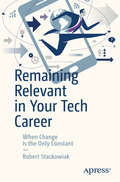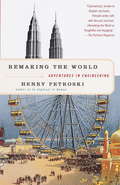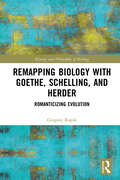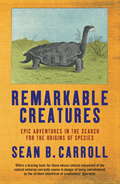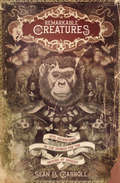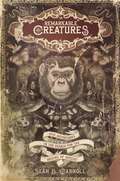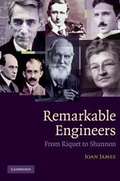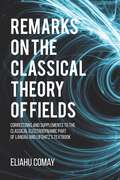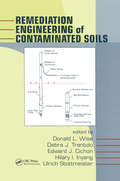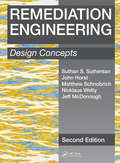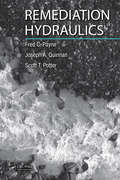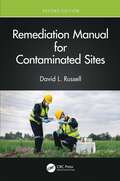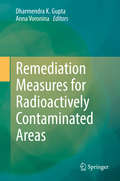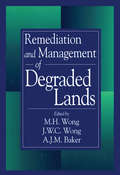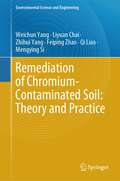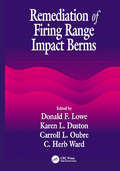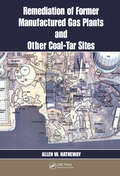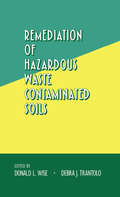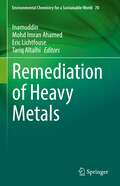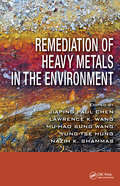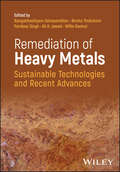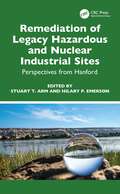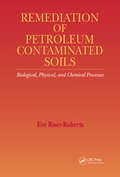- Table View
- List View
Remaining Relevant in Your Tech Career: Navigating Over A Lifetime Of Constant Change
by Robert StackowiakRemain relevant in the face of constant change during your career in technology. This book shows you how to proactively plan in anticipation of future changes. Many people find technology careers enticing because of the number of job opportunities, the high compensation, or simply because of fascination with technology itself. Once in those careers, however, there are many challenges to remaining relevant and at one’s peak in the face of constantly shifting competitive and technology landscapes. Incumbents face a constant stream of new skills to learn that are often already known by more recent graduates entering the market at lower compensation rates. There also are time-to-market challenges and the need to keep up with the introduction of automation.This book was written based on the author’s experience gained over 40 years working with and in technology-related fields and companies. It provides practical guidance on remaining relevant as changes are expected to occur in technology at ever faster rates in coming decades.What You'll LearnKnow what companies really wantRealize the importance of alignment with company cultureUnderstand the political landscape and how to use it to advantageDiscover why creating, maintaining, and operating in a diverse environment is beneficialMaster strategies for skills developmentFuture-proof your careerWho This Book Is ForTechnology professionals who want to remain relevant and happy while navigating their current career and university students who are pursuing a STEM career and actively planning their future
Remaking the World: Adventures in Engineering
by Henry PetroskiA selection of 19 articles (most) first published in "American Scientist" by the engineer/author notable for his interest in giving engineers a broader sense of their field, and giving the general public an appreciation of the art and science of engineering. Among Petroski's previous works are "The Evolution of Useful Things" and "To Engineer Is Human". Annotation c. by Book News, Inc. , Portland, Or.
Remapping Biology with Goethe, Schelling, and Herder: Romanticizing Evolution (History and Philosophy of Biology)
by Gregory RupikRemapping Biology with Goethe, Schelling, and Herder recruits a Romantic philosophy of biology into contemporary debates to both integrate the theoretical implications of ecology, evolution, and development, and to contextualize the successes of the Modern Evolutionary Synthesis’s gene’s-eye-view of biology.The dominant philosophy of biology in the twentieth century was one developed within and for the Modern Evolutionary Synthesis. As biologists like those developing an Extended Evolutionary Synthesis have pushed the limits of this paradigm, fresh philosophical approaches have become necessary. This book makes the case that an organicism developed by the 19th century figures Goethe, Schelling, and Herder offers surprising resources to navigate the contemporary biological and evolutionary terrain. This “metamorphic organicism” resonates with present trends in biological theory that emphasize process, organismal dynamics, ecology, and agency. It also proposes strategies for reintegrating reductive and mechanistic maps of biology, like those of the Modern Evolutionary Synthesis, into richer theoretical representations of life.Drawing from cutting-edge biology, Romantic history, and perspectival pluralist literatures, this integrated history-and-philosophy-of-biology will be of interest to students and scholars interested in the genesis of current theoretical tensions in evolutionary biology, and to those seeking constructive ways to resolve those tensions, including practicing biologists and educators.
Remarkable Creatures: Epic Adventures in the Search for the Origins of Species
by Sean B. CarrollIn 1809, when Darwin was born, much of the world was an unexplored wilderness. Our knowledge of the past was nonexistent, and our picture of our species' history little more than a set of fantastic myths and fairytales. But a new era was dawning. Five decades later, On the Origin of the Species was able to draw on the pioneering work of explorers and naturalists to produce a theory that revolutionized our conception of our world. And the revolution didn't stop with the publication of Darwin's masterwork. 150 years later, his 'dangerous idea' is still headline news, denied by many, capable of enraging and dividing, even as biologists decipher the 3-billion-year history of life as written in our very DNA.This book tells the stories of the most dramatic adventures and important discoveries in two centuries of natural history - from Alexander von Humboldt's epic journeys in South America to the hi-tech genome-reading projects making headlines today - and how they gave birth to and have nourished the evolution revolution.
Remarkable Creatures: Epic Adventures in the Search for the Origins of Species
by Sean B. CarrollNational Book Award Finalist: A biologist&’s &“thoroughly enjoyable&” account of the expeditions that unearthed the history of life on our planet (Publishers Weekly). Not so long ago, most of our world was an unexplored wilderness. Our sense of its age was vague and vastly off the mark, and much of the knowledge of our own species&’ history was a set of fantastic myths and fairy tales. But scientists were about to embark on an amazing new era of understanding. From the New York Times–bestselling author of The Big Picture, this book leads us on a rousing voyage that recounts the most important discoveries in two centuries of natural history: from Darwin&’s trip around the world to Charles Walcott&’s discovery of pre-Cambrian life in the Grand Canyon; from Louis and Mary Leakey&’s investigation of our deepest past in East Africa to the trailblazers in modern laboratories who have located a time clock in our DNA. Filled with the same sense of adventure that spurred on these extraordinary men and women, Remarkable Creatures is a &“stirring introduction to the wonder of evolutionary biology&” (Kirkus Reviews). &“Charming and enlightening.&” —San Francisco Chronicle &“As fast-paced as a detective story.&” —Nature
Remarkable Creatures: Epic Adventures in the Search for the Origins of Species, 1st Edition
by Sean B. CarrollThis book takes us on the dramatic expeditions that unearthed the history of life on our planet. Sean Carroll leads a rousing voyage that recounts the most important discoveries in two centuries of natural history.
Remarkable Engineers
by Ioan JamesJames (mathematics, U. of Oxford, UK) documents the life stories of 51 engineers from the seventeenth to the twentieth centuries who pioneered the design and building of railways, bridges, airplanes, communications, radio and television, automobiles, electronics, and were involved in space research. He emphasizes their life stories over their achievements, and arranges profiles chronologically, which feature engineers from Western and Eastern Europe and the US, and include Pierre-Paul Riquet, Thomas Telford, John Rennie, Richard Trevithick, George Stephenson, Charles Babbage, John Ericsson, Gustave Eiffel, Thomas Edison, Alexander Graham Bell, Hertha Ayrton, Nikola Tesla, Heinrich Hertz, Wilbur and Orville Wright, Wernher von Braun, and Edith Clarke. B&w portraits and photos are included. No index is provided. Annotation ©2010 Book News, Inc. , Portland, OR (booknews. com)
Remarkable Plants of Texas: Uncommon Accounts of Our Common Natives (Corrie Herring Hooks Series)
by Matt Warnock Turner&“No single existing publication includes the kind of information featured in this book,&” a natural history of the flora of the Lone Star State (A. Michael Powell, Professor of Biology Emeritus and Director of the Herbarium, Sul Ross State University). With some 6,000 species of plants, Texas has extraordinary botanical wealth and diversity. Learning to identify plants is the first step in understanding their vital role in nature, and many field guides have been published for that purpose. But to fully appreciate how Texas&’s native plants have sustained people and animals from prehistoric times to the present, you need Remarkable Plants of Texas. In this intriguing book, Matt Warnock Turner explores the little-known facts—be they archaeological, historical, material, medicinal, culinary, or cultural—behind our familiar botanical landscape. In sixty-five entries that cover over eighty of our most common native plants from trees, shrubs, and wildflowers to grasses, cacti, vines, and aquatics, he traces our vast array of connections with plants. Turner looks at how people have used plants for food, shelter, medicine, and economic subsistence; how plants have figured in the historical record and in Texas folklore; how plants nourish wildlife; and how some plants have unusual ecological or biological characteristics. Illustrated with over one hundred color photos and organized for easy reference, Remarkable Plants of Texas can function as a guide to individual species as well as an enjoyable natural history of our most fascinating native plants.
Remarks on The Classical Theory of Fields: Corrections and Supplements to the Classical Electrodynamic Part of Landau and Lifshitz's Textbook
by Eliahu ComayThis book undertakes the unusual task of correcting and proposing supplements to the Landau and Lifshitz's highly celebrated textbook titled: The Classical Theory of Fields 1, which has been extraordinarily influential. Its first edition was publis
Remediation Engineering of Contaminated Soils (Environmental Science & Pollution)
by Donald L. WiseOffers thorough coverage of the remediation of soils contaminated by hazardous wastes, including materials, analytical techniques, cleanup design and methodology, characterization of geomedia, monitoring of contaminants in the subsurface, and waste containment. Cites specific case studies in hydrocarbon remediation that offer a concise overview of possible technological approaches.
Remediation Engineering: Design Concepts, Second Edition
by John Horst Suthan S. Suthersan Matthew Schnobrich Nicklaus Welty Jeff McDonough"This second edition of Remediation Engineering will continue to be the seminal handbook that regulators must have on-hand to address any of the remediation issues they are grappling with daily. The book is wide-ranging, but specific enough to address any environmental remediation challenge." —Patricia Reyes, Interstate Technology Regulatory Council, Washington, DC, USA "This book offers the researcher, teacher, practitioner, student, and regulator with state-of-the-art advances in conducting site investigations and remediation for common and emerging contaminants. It is revolutionary in its approach to conducting subsurface investigation, which greatly influences a successful and appropriate response in assessing and addressing environmental risk. This book is a giant leap forward in understanding how contaminates behave and how to reduce risk to acceptable levels in the natural world." —Daniel T. Rogers, Amsted Industries Incorporated, Chicago, Illinois, USA "This text is a superb reference and a good tool for learning about state-of-the-art techniques in remediation of soil and groundwater. [It] will become a ready reference at many companies as the engineering community creates increased value from remediation efforts around the world." —John Waites, AVX Corporation, Fountain Inn, South Carolina, USA Remediation Engineering was first published in 1996 and quickly became the go-to reference for a relatively young industry, offering the first comprehensive look at the state-of-the-science in treatment technologies of the time and the contaminants they applied to. This fully updated Second Edition will capture the fundamental advancements that have taken place during the last two decades within all the subdisciplines that form the foundation of the remediation engineering platform. It covers the entire spectrum of current technologies that are employed in the industry and also discusses future trends and how practitioners should anticipate and adapt to those needs. Features: Shares the latest paradigms in remediation design approach and contaminant hydrogeology Presents the landscape of new and emerging contaminants Details the current state of the practice for both conventional technologies, such as sparging and venting Examines newer technologies such as dynamic groundwater recirculation and injection-based remedies to address both organic and inorganic contaminants. Describes the advances in site characterization concepts such as smart investigations and digital conceptual site models. Includes all-new color photographs and figures.
Remediation Hydraulics
by Fred C. Payne Joseph A. Quinnan Scott T. PotterIn situ treatments involving the arrangement of contact between prospective reactants in complex porous media require a refined understanding of solute migration. However, the tools and methods used to predict and control fluid movement in the subsurface need significant improvement. Practitioners and regulators must develop novel methods to
Remediation Manual for Contaminated Sites
by David L. RussellBased on the author’s more than 40 years of experience working on environmental projects, Remediation Manual for Contaminated Sites provides a practical guide to environmental remediation and cleanups. It presents a broad overview of the environmental remediation process, distilled into what one needs to know to evaluate a specific challenge or solve a remediation problem. The text offers guidance on tasks that range from managing consultants and contractors to gathering data, selecting a suitable remediation technology, and calculating remediation costs. This new edition is updated throughout, includes five new chapters, and provides a more global coverage.• This book includes remediation strategies for a variety of contaminants and examines a wide range of technologies for the remediation of water and soil, including excavation, wells, drainage, soil venting, vapor stripping, incineration, bioremediation, containment, solidification, vitrification, and phytoremediation.• Written as a down‑to‑earth reference for professionals faced with the challenges of remediating a contaminated site, this book is also useful as a primer for students and those new to the field. It includes numerous figures, photographs, tables, and helpful checklists.• This new edition adds five all‑new chapters. It presents a more global approach and practical examples from around the world.
Remediation Measures for Radioactively Contaminated Areas
by Dharmendra K. Gupta Anna VoroninaThis book offers extensive and comprehensive knowledge to the researchers and academicians who are working on decontamination of radioactively contaminated areas. Remediation strategies for contaminated sites are provided. Readers who will find this book useful include professionals specializing in radioecology, safe disposal of radioactive waste, as well as decontamination, remediation legacies and impact of radioactive waste material on the environment. The chapters give a broad overview and reviews of a number of original publications on remediation strategies that were explored after the Chernobyl and Fukushima Nuclear Power plant accidents. Useful case studies are provided that explore the latest technological developments and future trends for affected area decontamination.
Remediation and Management of Degraded Lands
by MH WongRemediation and Management of Degraded Lands presents the program of the first International Conference on the Remediation and Management of Degraded Lands. This collection reviews the extent of resource debasement and offers solutions for their restoration. The 14-part first section deals with mine management and rehabilitation. Topics include the devastating results of open-cut mining, open-pit mining, lignite surface mining and acid mining. Despite such ruin, the articles reveal the possibilities for reclamation. Part two devotes nine chapters to the management of derelict lands. Reforestation, soil fertility prognosis, and the uses of nitrogen are just a few of the covered subjects. This portion of the book pays special attention to the successful results of remediation in China and Hong Kong. The final division addresses soil contamination and reclamation. There are eleven chapters on subjects that include the single and interactive effects of aluminum, the effectiveness of EDTA/HCI and the value of pig-on-litter compost as a tool for edible crop growth. These and other innovative techniques make Remediation and Management of Degraded Lands a valuable addition to any environmental library.
Remediation of Chromium-Contaminated Soil: Theory and Practice (Environmental Science and Engineering)
by Weichun Yang Liyuan Chai Zhihui Yang Feiping Zhao Qi Liao Mengying SiIn accordance with the global needs of heavy metal-contaminated site remediation, this book systematically introduces the latest theories and technical achievements of microbial and chemical treatment for the chromium pollution in the chromium slag and chromium-contaminated soil, combined with the author's research achievements over the decades. The book focuses on the biological and chemical behavior of chromium in soil, microbial, and chemical remediation for the chromium-contaminated soil and the cases of chromium-contaminated site remediation project. This book is used by the scientific researchers and engineering technicians engaged in chromium chemical industry and environmental protection. It is also used as a textbook and reference book for graduate students in environmental science and engineering, soil science, chemistry and chemical engineering, and other related fields.
Remediation of Firing Range Impact Berms
by C. H. WardA part of the continuing effort to provide innovative in situ remediation techniques, Remediation of Firing-Range Impact Berms presents the results of a soil washing and leaching project. The demonstration set as its primary objective providing reliable, detailed performance data to evaluate the feasibility and cost of implementing a full-scale sys
Remediation of Former Manufactured Gas Plants and Other Coal-Tar Sites
by Allen W. HathewayWinner of the 2013 Claire P. Holdredge Awardee for Remediation of Former Manufactured Gas Plants and Other Coal-Tar Sites.This award, first established in 1962 by the Association of Environmental and Engineering Geologists, is named in honor of Claire P. Holdredge, a founding member and the first President of the Association. The award is
Remediation of Hazardous Waste Contaminated Soils
by DonaldL. Wise""This unique, single-source reference offers a thorough treatment of the remediation of soils contaminated by hazardous wastes and the scientific and engineering issues that must be addressed in creating practical solutions for their reclamation.
Remediation of Heavy Metals (Environmental Chemistry for a Sustainable World #70)
by Eric Lichtfouse Inamuddin Mohd Imran Ahamed Tariq AltalhiThe book presents recent remediation techniques for heavy metal contamination in wastewater, with a focus on recently-developed and sustainable materials such as metal oxides and their composites, two-dimensional materials, organic-inorganic ion exchange materials, nanomaterials, bagasse, and olive-oil waste chelating materials. Chapters also describe the analysis of heavy metals, membranes for water treatment, sources and impact of heavy metals and opportunities and challenges in heavy metal remediation.
Remediation of Heavy Metals in the Environment (Advances in Industrial and Hazardous Wastes Treatment)
by Lawrence K. Wang Yung-Tse Hung Nazih K. Shammas Jiaping Paul Chen Mu-Hao Sung WangThis book provides in-depth coverage of environmental pollution sources, waste characteristics, control technologies, management strategies, facility innovations, process alternatives, costs, case histories, effluent standards, and future trends in waste treatment processes. It delineates methodologies, technologies, and the regional and global effects of important pollution control practices. It focuses on toxic heavy metals in the environment, various heavy metal decontamination technologies, brownfield restoration, and industrial, agricultural, and radioactive waste management. It discusses the importance of metals such as lead, chromium, cadmium, zinc, copper, nickel, iron, and mercury.
Remediation of Heavy Metals: Sustainable Technologies and Recent Advances
by Pardeep Singh Rangabhashiyam Selvasembian Binota Thokchom Ali H. Jawad Willis GwenziRemediation of Heavy Metals Meet the challenge of contaminated water with a range of sustainable tools The treatment of water which has been polluted by heavy metals is an increasingly significant environmental challenge in an industrialized global economy. The ongoing revolution in green technologies, however, has seen a range of sustainable methods emerge for treating water, soils, and other parts of the environment polluted by trace metals. By putting these methods into practice, environmental researchers and industrial professionals can improve water quality, and public health globally. Remediation of Heavy Metals offers a clear, accessible reference on these methods and their applications. It offers an overview of the major effects of heavy metal contamination and works through each of the methods or protocols available to remediate soil and minimize pollution at the source. Remediation of Heavy Metals readers will also find: Comparison of different approaches for heavy metal removal Detailed discussion of physical, chemical, and biological remediation methods Case studies demonstrating proper remediation Remediation of Heavy Metals provides key knowledge for environmental scientists, environmental toxicologists, and other researchers or industrial professionals working in heavy metal removal, as well as advanced graduate students in these areas. Rangabhashiyam Selvasembian, PhD, Associate Professor, Department of Environmental Science and Engineering, School of Engineering and Sciences, SRM University-AP, Amaravati, India Binota Thokchom, PhD, DST-Inspire faculty member at the Centre of Nanotechnology, Indian Institute of Technology, Guwahati, India. Pardeep Singh, PhD, Assistant Professor in the Department of Environmental Science, PGDAV College University of Delhi, New Delhi, India. Ali H. Jawad, PhD, Associate Professor in the Faculty of Applied Sciences, Universiti Teknologi MARA, Selangor, Malaysia. Willis Gwenzi, PhD, Leibniz Institute of Agricultural Engineering and Bio-economy e.V. (ATB), Potsdam, Germany, and Universität Kassel, Witzenhausen, Germany.
Remediation of Legacy Hazardous and Nuclear Industrial Sites: Perspectives from Hanford
by Stuart T. Arm Hilary P. EmersonRemediation of Legacy Hazardous and Nuclear Industrial Sites provides an overview of the key elements involved in remediating complex waste sites using the Hanford nuclear site as a case study. Hanford is one of the most complex waste sites in the world and has examples of most, if not all, characteristics of the complex waste sites that exist globally. This book is aimed at a non-technical audience and describes the stages of remediation based on general RCRA/CERCLA processes, from establishing a strategy that includes all stakeholders to site assessment, waste treatment and disposal, and long-term monitoring.Features: Informs a non-technical audience of the important elements involved in complex waste site remediation Employs the Hanford Site as a case study throughout to explain real-world applications of remediation steps Connects the “human” element to the technical aspects through interviews with key current and retired individuals at the Hanford Site Includes discussion of stakeholders and the engagement process in remediation Demonstrates how all elements of complex waste site remediation from demolition of buildings to groundwater management are interrelated Focuses on broader technical and sociopolitical challenges for remediation of a contaminated site Aimed at a broad audience, this book offers approachable guidance to technical and non-technical readers through a series of real-world examples that cover each important step in the complex waste cleanup process.
Remediation of Petroleum Contaminated Soils: Biological, Physical, and Chemical Processes
by Eve Riser-RobertsThis book combines the results of current research with essential background material to provide complete, in-depth coverage of every aspect of in situ and ex situ bioremediation, as well as an extensive overview of the physical and chemical processes currently available for treating petroleum-contaminated soils. Critical information has been collected and assembled under one cover to provide a convenient reference for anyone who must contend with this worldwide problem.Remediation of Petroleum Contaminated Soils: Biological, Physical, and Chemical Processes describes how to optimize the biodegradation of petroleum hydrocarbons in soil-water systems. It reports on the susceptibility of various petroleum components to biodegradation by microorganisms, and considers all groups of microorganisms for their potential contributions. The book also deals with problem areas such as the transport of organisms, oxygen, or nutrients throughout the subsurface, as well as biodegradation of polynuclear aromatic hydrocarbons (PAHs) and nonaqueous phase liquids (NAPLs). In addition, the book presents a variety of methods for monitoring bioremediation.This reference discusses current soil remediation processes and includes many innovative approaches. It also investigates means of controlling volatile organic compounds (VOCs) and leachate, and addresses methods for collecting and treating these secondary waste streams. The expansive coverage of this book will furnish readers with a wide range of options for developing treatment strategies and for customizing procedures for specific requirements.
Remember
by Eileen CookA thrilling tale about what a girl will do to get back a memory she lost...or remove what she wants to forget.Harper is used to her family being hounded by protestors. Her father runs the company that trademarked the "Memtex" procedure to wipe away sad memories, and plenty of people think it shouldn't be legal. Then a new demonstrator crosses her path, Neil, who's as persistent as he is hot. Not that Harper's noticing, since she already has a boyfriend. When Harper suffers a loss, she's shocked her father won't allow her to get the treatment, so she finds a way to get it without his approval. Soon afterward, she's plagued with strange symptoms, including hallucinations of a woman who is somehow both a stranger, yet incredibly familiar. Harper begins to wonder if she is delusional, or if these are somehow memories. Together with Neil, who insists he has his own reasons for needing answers about the real dangers of Memtex, Harper begins her search for the truth. What she finds could uproot all she's ever believed about her life...
